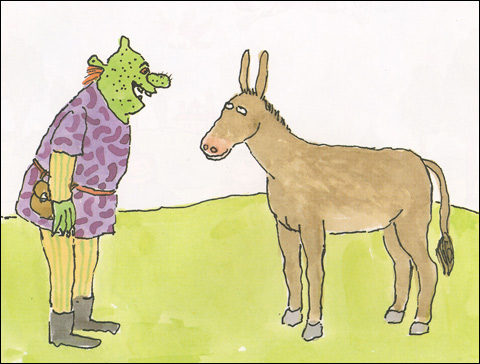
WAS THIS THE DONKEY THE WITCH FORETOLD! Steig’s Shrek is different from Mike Myers’s. |
Is anything more delicious than being naughty? That might be the moral of William Steig's 1990 kids' picture book
Shrek! — if
Shrek! were the kind of story that
has a moral. Instead, it's an upside-down fairy-tale quest told from the monster's point of view —
Grendel for the pre-school set. It's sometimes hard to remember, all these
Shrek sequels later, that the Mike Myers–voiced jolly green ogre was once fresh and funny. But Steig's book was even, uh, worse: after Shrek's parents kick him out of the black hole in which he was hatched, he swallows lightning, zaps a dragon, roasts a knight, and weds "the most stunningly ugly princess on the surface of the planet." Of course, "they lived horribly ever after."
Shrek! represents the twin poles of Steig's brilliance: the curmudgeon and the heart of gold. He was a devoted humanist who seemed fed up with people but was willing to give them another shot. This combination, plus a generous helping of fantasy and, of course, a knack for drawing, made him one of the great children's-book illustrators and New Yorker cartoonists of the past century. Which in turn makes him one of the greatest artists of the era, too.
At the Norman Rockwell Museum, "William Steig: Love & Laughter" crams more than 200 works into three rooms. All but one come from a gift of more than 800 artworks that Steig's fourth wife, Jeanne (whom he married in 1973), recently donated to the museum. It's the largest gift the Rockwell has received in its 41-year history.
Steig was born in Brooklyn in 1907 and grew up in the Bronx. When the Depression hit, his house-painter father found himself with little work, and his savings, which he'd invested in the stock market, were gone. "My dad told me I would have to support the family," Steig told Lee Lorenz for the 1998 book The World of William Steig. "I knew I could draw. I didn't know if I could make any money at it, but it seemed like the best thing to try." By the end of 1930, his first year as a cartoonist, he'd earned more than $4000. By the time of his death, in 2003 (he spent his last years in Boston), he had contributed 123 covers and 1676 drawings to the New Yorker.
Founded in 1925, the New Yorker invented single-panel gag cartooning as we know it today, beginning, in particular, with the suave nightlife jokes of Peter Arno and Helen Hokinson. Steig's early cartoons are populated by snooty swells and stout working-class folks in tenements overflowing with children. His brawny lines transmitted the earthy humor of city streets. But Steig had higher aspirations; he was inspired by Picasso and Freudian thought, the latter by way of the psychiatrist Wilhelm Reich, to whom he went for treatment in the mid 1940s. (Steig became a lifelong Reich devotee. At the artist's public memorial at the Boston Public Library in 2004, a personal trainer recalled how Steig had talked him into trying out his orgone box.) The result was a series of what Steig called "symbolic drawings," surreal psychological sketches, like one of a gray-flannel-suit type in a sour-eyed bird mask. It was captioned "Spiteful little man."